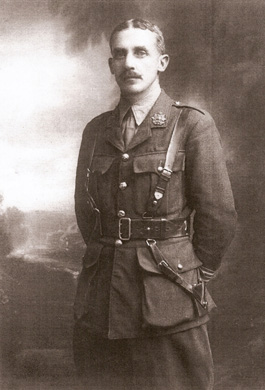Lewis Ironside Wood was born in Melton Hall on 11th September 1866, the youngest son of John Richard Wood and Frances Isabella Woodhouse. He was educated at Rugby School and later at schools in France and Germany, before attending the Royal Military College, Sandhurst in 1884.
Lewis graduated from Sandhurst in 1887 and was then commissioned as a Second Lieutenant in the Border Regiment and posted to the 2nd Battalion. Two years later, he had been promoted again, this time to Lieutenant. Lewis travelled abroad on active service, taking part in the Chin-Lushai and Waziristan Expeditions in India.
In May 1896, Lewis was promoted to Captain and sent to South Africa where he took part in the Boer War. There, he received the Queen’s Medal and four clasps for actions, including Operations in Transvaal and Orange River Colony. When the Boer War ended, Lewis remained in South Africa and worked for the South African Constabulary until 1905. In 1911, Lewis was promoted to Major and made Commandant of the Mounted Infantry School in India. In 1913, Lewis received his final promotion to Lieutenant Colonel and was placed in command of the 2nd Battalion Border Regiment.
At the outbreak of the First World War, the 2nd Border Regiment was posted to France, arriving on 15th October 1914 as part of the 7th Division. They were then sent to the Ypres salient and took part in battles in the area and at Neuve Chapelle and Festubert. On 29th October 1914, Lewis lead his men in an attack on Kruisek Hill close to the Menin- Ypres road. The war diary entry reads:
“On reaching the first ridge the Battalion came under terrific direct shell, machine gun and rifle fire. After an hour’s wait, the Battalion advanced under Lieut-Col L I Wood who was almost immediately hit.”
Lewis was treated for his injuries in Britain and he returned to the command of his battalion on 9th January 1915. On 18th February 1915, King George V conferred the appointment of Companion of the Order of St Michael and St George (C.M.G.) to Lewis in recognition of meritorious service during the war.
In March 1915, the 2nd Border Regiment was in action at Neuve Chapelle and once again Lieutenant Colonel Lewis Wood lead his men at the front. The war diary describes 12th March:
“The attack was ordered to take place at 10.30am precisely. At 10.30 "C" Company moved forward and immediately came under heavy machine gun and rifle fire with a company of Scots Guards on their right. The attack continued for about 15 minutes but the casualties in both Regiments were so heavy that Lieut Colonel L.I. Wood ordered the advance to stop until strong artillery fire or covering fire could be brought to bear.
At this critical time, 20 minutes after the attack had been launched, an order arrived to say the attack would be postponed until 12.30pm. As this order did not arrive till 10.50am nothing could be done except wait in the present position for the Artillery Bombardment. At 12 midday the Artillery commenced their bombardment. At about 12.20 Lieut- Colonel Wood again gave the order to advance, although still enfiladed. The Battalion pushed on and got close up to the enemy’s positions and rushed it just as the guns ceased firing. The Germans came out holding up their hands and waving handkerchiefs. Some 200 prisoners were taken and large quantities of rifles, bayonets, and ammunition.”
April was to be a quiet month for the battalion and it was reported in a local paper that Lewis returned to London to receive the C.M.G. from the King at Buckingham Palace on 30th April. The 2nd Border Regiment was in billets at Hinges upon his return, after which they received orders to go into trenches at Festubert. By 09:00 on 15th May, the battalion was in trenches on the front line preparing for an attack the following morning, with zero hour set for 03:15 on the 16th.
The attack commenced under the supervision of Lewis and was almost immediately halted due to shells from the British artillery that continued after the barrage should have stopped. At the second attempt, “A” Company achieved their first objective of the German trenches, but not without heavy losses. The line in the German trenches was then consolidated when “B” Company pushed forward to occupy them. The battalion’s position was further strengthened by two machine guns being brought to the line and “C” and “D” Companies lengthening the line to the right.
The war diary goes on to say:
“During these operations, the battalion suffered very heavily. Lieut-Col. L.I. Wood was wounded midway between the British & German trenches and was brought in by Sgt. Maj. Davenport and Corporal Coleman but died as soon as he reached the British lines.”
Lieutenant Colonel Wood’s obituary gave a further description of events that day:
“in the fierce engagement at Festubert, on May 16th, he was shot as he stood on the edge of a stream directing his men. He fell into the water, from which he was rescued by the Adjutant, Lieutenant Burman, and Sergent Major Davenport with Corporal Coleman (the Colonel’s servant) afterwards carried him back, amidst a storm of bullets, to the British lines where he almost immediately expired.”
Lewis Ironside Wood was forty-eight when he died and was laid to rest in Le Touret Military Cemetery, Richebourg-l'Avoué, France.
In addition to his C.M.G., Lewis received the 1914 Star with Clasp and Rose, and the British War and Victory Medals for his service during the First World War.

